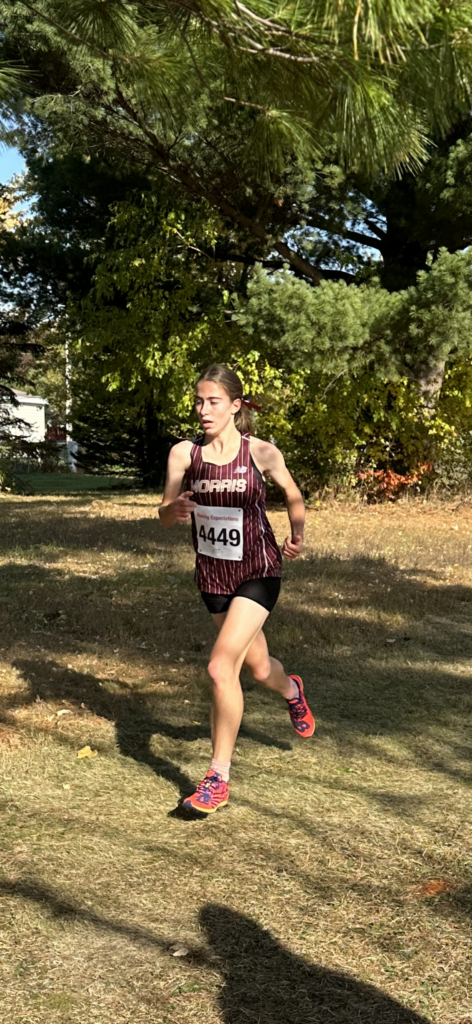It’s never too late for a “Best Of Last Year” list! (Checks calendar.) Well, I’m pushing it, faithful readers, but I have a valid excuse: We adopted a 6-year-old rescue dog who eats up all of my time. With zero information about what type of training she had had before, we’re trying to get her to follow some modicum of decency around us. She’s basically middle aged in human years; it’s like I’m mansplaining our house rules to a 42-year-old woman.
Anyway, the books. I read 35 books in 2024. I was selective and actually abandoned some books mid-read, thus much of what I finished was stuff that I liked. My top 10 could really be a top 20 (I wish I had time to give descriptions on all the “Books That Just Missed the Cut” below, but see above about timesucking dog.)

- Glorious Exploits, Ferdia Lennon. A hilarious and heartbreaking historical novel unlike any I’ve read, Irish author Lennon’s debut and hopefully not his last. Based on the true events of the Peloponnesian War, when in 412 BCE the Athenian navy attacks Syracuse but is defeated; hundreds of Athenians are captured and imprisoned in a rock quarry, where they are guarded but not given provisions, left to waste away. (Bear with me here.) Two local Syracusans, Lampo and Gelon, come up with a plan to have the Athenian prisoners stage their countryman Euripedes’ recent play “Medea.” Uniquely told in contemporary Irish language, this book deftly maneuvers between comedy, tragedy, revenge, injustice, war, finding humanity in our enemies and inhumanity in our friends, love, and how to have hope when all seems lost.

2. You Could Make This Place Beautiful, Maggie Smith. This memoir by the poet Maggie Smith is so specific that I couldn’t believe it would work: It starts when Smith discovers that her husband is cheating on her. What follows is devastating, wryly funny, and (of course, considering she is a poet) beautifully worded. This is a revenge memoir, but I am sure Smith would bristle at that description. Some chapters are just a few words long but still hit like bombs. You might recognize Smith’s most famous poem, “Good Bones,” which went viral when it was published. Here, she ruminates on what “success” means, how to protect one’s children, and how to live with and move on from heartbreak.

3. Sandwich, Catherine Newman. At this point, I would read Newman’s grocery list and probably be entertained. She tells stories that feel so real and lived-in. In this one, the narrator is Rocky, a 50-something woman who is planning her family’s annual weeklong visit to Cape Cod. Her kids are (nearly) grown up, her parents are aging and showing signs of losing their independence, her relationship with her husband has its fluctuations, and meanwhile she’s trying to keep everyone fed and happy. Very relatable, funny, and moving. Newman’s ability in particular to describe family dynamics and lay out what a healthy, respectful relationship with the younger generation can look like are what bring me back to her stories.

4. Intermezzo, Sally Rooney. At this point, I would read Rooney’s grocery list and…dang it, I already used this analogy. But Rooney’s grocery list would probably include graphic lovemaking scenes, so there’s that. Rooney is an Irish author who is so adept at illustrating modern relationship problems and getting the reader to root for multiple characters pitted against each other. This story is about two brothers, 10 years apart in age, in Dublin dealing the with death of their father and their strained connection to each other. Peter, the older brother, is balancing his law practice and situations with his ex, Sylvia, who has chronic pain, and a much younger college student, Naomi, with whom he has almost nothing in common. His brother, Ivan, is a socially awkward former chess prodigy who struggles to find his place in the world and falls in with a much older woman, Margaret, who runs an arts program in rural Ireland. Overlaying all of this is what each brother interprets about each other’s lives and what their father would have thought of them.

5. Practice, Rosalind Brown. English author Brown’s debut novel is for anyone who has procrastinated on a writing assignment (ahem, see first paragraph above). Low-key funny story about Annabel, a student at Oxford who is supposed to be writing an essay about Shakespeare’s sonnets. We hear about all the things that Annabel does as the minutes and hours tick away that don’t involve writing: heating up tea, having breakfast, doing yoga, reheating tea, going for a walk, ruminating on her not-great relationship with a much older man, recounting her sexual history, all told in a semi stream of conscious way. This reminded me of a college roommate I had who stated about 3 weeks before finals: “Okay, if I read 35 pages a day in all my texts, I’ll be caught up at the start of finals week and be able to study.” Next day: “If I read 36.75 pages a day, I’ll finish.” Cut to 3 days before finals: “If I read 245 pages a day…” Annabel puts herself in an untenable position in terms of finishing her essay, and we get to be along for the absurdity of it.

6. The Vulnerables, Sigrid Nunez. I’ve avoided reading “pandemic novels,” stories that try to set things in the near past to provide some sort of commentary on what we all lived through in 2020-2021. I didn’t think I could come across one that would distill things in a way that didn’t feel forced or obvious. Leave it to a National Book Award winner to produce this slim, page-turning story of an older woman who finds unlikely allies during the pandemic (a Gen Zer with whom she finds herself sharing an apartment, a parrot that she ends up long-term birdsitting). This was the type of story that I ended wondering what happened next, and when world events take a turn, I wonder how our narrator would be thinking about them.

7. North Woods, Daniel Mason. This weighty novel deviates from the fictional norm of following characters over the length of the story but rather stays in one place and tells the story of a cabin built in New England by two lovers escaping from a Puritan colony, and we follow the next few hundred years as various inhabitants take over the cabin as it gets expanded and renovated: a deserting English soldier, a pair of never-married twin sisters, a painter, and at times the wildlife that take over the abandoned property, including an ever-present panther, rumored to have survived in New England long after being thought wiped out in that part of the country. Told in the epistolary style (as a series of collected writings, letters, journal entries, nature diaries, etc.), somehow this whole mishmash works, and things that we see in earlier stories circle back and never quite leave. What’s fun is when, in later chapters, newer owners are trying to piece together mysteries (e.g., human remains buried in the yard), and the reader knows what they don’t.

8. Blood In the Machine: The Origins of the Rebellion Against Big Tech, Brian Merchant. This nonfiction work by Merchant, a technology expert, is really a tragedy whose end we already know before reading it. Merchant explains the origins of the term “Luddite,” and how our general knowledge of the meaning (i.e., someone who hates new technology) was purposely distorted by the factory owners who were exploiting tradespeople in England in the 1800s as factory work exploded during the Industrial Revolution. Merchant then connects the battle that English craft and trade workers waged but lost against both the owners and eventually the British Crown with our current dilemmas with artificial intelligence and the ever-increasing rise in automation that threatens to once again eliminate a whole class of workers. This is a tale we see playing out in the current US administration, where “efficiency” means “eliminating jobs to provide more money to the wealthy and corporations,” but we are sold the story that it means that everyone will have free time and get rich. It never works out that way, and learning the story of General Ned Ludd and his various incarnations offers just a glimmer of hope in how to set policy that doesn’t further the gap between rich and poor.

9. Play It As It Lays, Joan Didion. If you’ve never read Didion, who died in 2021, I suggest revisiting some of her works, and her 1970 novel is as good a place to start as any of her works. It’s a searing tale of a woman who, we slowly discover, has suffered a mental breakdown that was treated with powerful drugs, and the story behind what actually happened in her hard life. The protagonist, Maria Wyeth, is a housewife in Hollywood, a far cry from her difficult childhood in a small Nevada mining town, and we flash forward and backward to hear her life. Maria’s young daughter, we learn, is institutionalized, and she wages a battle to get her out. Difficult topics covered include suicide, illegal abortion, lack of knowledge about mental illness, and divorce.



10-12. A trio of books by Sloane Crosley: Cult Classic, Grief Is For People, How Did You Get This Number. This is a cheat, I know, but I did a deep dive into Crosley’s writing, both fiction and memoir, and couldn’t choose just one. Her acerbic voice weaves through all three books: one (Cult Classic) a novel about a woman in New York City who keeps running into her ex-boyfriends and slowly realizes that these coincidences just might be a mind control exercise being performed on her by her ex-boss; the next (Grief) a poignant memoir about trying to move on with her life after two traumatic events within a month of each other: her apartment is robbed of her grandmother’s jewelry and her best friend commits suicide and leaves his loved ones no clues as to why; and the third (Number) an early collection of personal essays that showcase Crosley’s singular voice. I’ve been a fan of Crosley since reading her novel The Clasp; go back and read that one while you’re at it.
Books that just missed the cut (but they deserve your love and attention!): Wild Houses, Colin Barrett; Crying in H Mart, Michelle Zauner; Fire Exit, Morgan Talty; I’m Glad My Mom Died, Jeannette McCurdy; The Vacationers, Emma Straub; This One Wild and Precious Life, Sarah Wilson; What I Ate in One Year, Stanley Tucci; Brothers, Alex Van Halen.































































